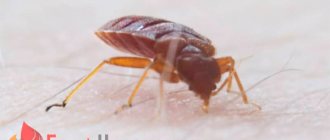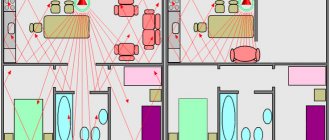The house mouse and gray rat have been “accompanying” humans since time immemorial - it is thanks to their ability to coexist with bipeds that these rodents have spread throughout the world and today are one of the most numerous species of mammals.
Alas, this neighborhood is not always favorable for humans. Mice and rats cause damage to crops, and cause the main damage by eating and contaminating food and animal feed with their excrement, as well as damaging furniture, electrical wiring, clothing, books and other items that they sharpen their teeth on.
But that's not all. Gray rodents are carriers of many infections that are dangerous and even in some cases fatal to humans. A number of such infections are transmitted through their urine and feces, others through blood-sucking arthropods that easily pass from mice to humans.
Let's talk in more detail about possible diseases transmitted by mice and rats to humans.
Hemorrhagic fever with renal syndrome (HFRS)
Hemorrhagic fever with renal syndrome (HFRS) is a group of clinically similar diseases caused by hantaviruses of the family Bunyaviridae.
Symptoms of Hemorrhagic Fever with Renal Syndrome (HFRS) usually develop within 1–2 weeks after exposure to infected materials, but in rare cases can take up to 8 weeks to develop. Initial symptoms appear suddenly and include severe headaches, back and abdominal pain, fever, chills, nausea and blurred vision. People may have facial flushing, sore or red eyes, or a rash. Late symptoms may include low blood pressure, acute shock, and acute renal failure, which can cause severe fluid overload. The severity of the disease varies depending on the virus causing the infection. Hantaan and Dobrava virus infections usually cause severe symptoms, while Seoul, Saaremaa and Puumala virus infections are more mild. Full recovery from rat disease may take weeks or months.
Hemorrhagic fever with renal syndrome occurs throughout the world. Haantan virus is widespread in East Asia, especially in China, Russia and Korea. Puumala virus is found in Scandinavia, Western Europe and Western Russia. The Dobrava virus is found mainly in the Balkans, while the Seoul virus is found throughout the world. The Saaremaa virus is found in Central Europe and Scandinavia. In America, hantaviruses cause another disease known as hantavirus pulmonary syndrome.
Hantaviruses are carried and transmitted by rodents. People can become infected with these viruses and develop hemorrhagic fever with renal syndrome after inhaling aerosolized urine, droppings, or saliva from infected rodents or after coming into contact with dust from their nests and cages. Infection can also occur when contaminated urine or other materials come into direct contact with broken skin or mucous membranes of the eyes, nose, or mouth. Additionally, people who work with live rodents can become infected with hantaviruses through the bites of infected rodents. Transmission from one person to another can occur but is extremely rare.
The gray or Norway rat (Rattus norvegicus) is a reservoir for the Seoul virus.
Typhoid
Infectious rats can transmit various forms of typhus - typhoid and typhoid. These are very dangerous diseases for people.
Symptoms of typhoid fever appear in the same way as with intoxication.
The main signs of infection are:
- weakness;
- diarrhea;
- migraine;
- heart rhythm disturbances;
- flatulence.
Typhus is characterized by rashes on the body, clouding of consciousness, even coma. Treatment is carried out with antibiotics. Timely assistance guarantees a favorable outcome.
Leptospirosis in rats
Leptospirosis is a bacterial disease that affects people and animals. Caused by bacteria of the genus Leptospira. People experience great variability in symptoms, some of which may be mistaken for other diseases. Some infected patients have no symptoms at all.
Left untreated, leptospirosis can lead to kidney damage, meningitis (inflammation of the lining of the brain and spinal cord), liver failure, respiratory distress, and even death.
The bacteria that causes leptospirosis is spread in the urine of infected animals. Urine can get into water or soil, and bacteria can survive there for weeks or even months. Many species of wild and domestic animals are carriers of leptospirosis. Carriers can be (not a definitive list): cattle, pigs, horses, dogs, rodents, wild animals.
Infected animals may not show clinical signs. Infected animals may continue to shed bacteria into the environment continuously or intermittently for months or even years.
People can become infected through:
- Contact with urine (or other body fluids excluding saliva) from infected animals
- Contact with water, soil or food contaminated with urine from infected animals
Bacteria can enter the body through the skin or mucous membranes (eyes, nose or mouth), especially if the skin is broken. Drinking contaminated water can also cause infection. Outbreaks of leptospirosis are usually caused by drinking contaminated water, such as after a flood. Person-to-person transmission is rare.
Natural infections
In fact, listing all the diseases that mice carry is quite problematic. The fact is that in laboratory conditions it is possible to infect a rodent with almost any infection that is contagious to humans.
In the natural environment, places where pathogens are concentrated are called natural focal reservoirs, from where viruses and bacteria are spread by rodents.
Natural focal diseases include leptospirosis, hemorrhagic fever, tularemia, yersiniosis, salmonellosis, helminthic infestations, etc. All of these infections are severe, many of them are difficult to treat, moreover, the recovery process and rehabilitation period takes a long time.
Lymphocytic choriomeningitis
Lymphocytic choriomeningitis (LCM) is an infectious viral disease. Transmitted by rodents, the causative agent is lymphocytic choriomeningitis virus (LCMV), a member of the family Arenaviridae, which was originally isolated in 1933.
The main host of the LCM virus is the common house mouse, Mus musculus. Infection in house mouse populations may vary depending on geographic location. House mice can transmit the virus throughout their lives without showing any signs of illness. Other rodents, such as hamsters, are not natural reservoirs but can become infected with lymphocytic choriomeningitis virus LCM from wild mice at a breeder, pet store, or home. Humans are most likely to become infected with lymphocytic choriomeningitis virus from house mice, but there is also evidence of infection from other domestic rodents.
Lymphocytic choriomeningitis virus disease has been reported in Europe, America, Australia and Japan and can occur where infected rodents are found.
Lymphocytic choriomeningitis most often presents with neurological symptoms, as the name suggests, although asymptomatic infection or mild fever is the more common clinical presentation.
In infected people, the first symptoms usually appear 8 to 13 days after exposure to the virus. The initial phase can last up to a week and usually begins with one or more symptoms: fever, malaise, lack of appetite, muscle pain, headache, nausea and vomiting. Other symptoms that appear less frequently include sore throat, cough, joint pain, chest pain, testicular pain, and parotid gland pain. In addition, pregnancy-associated infection is associated with congenital hydrocephalus, chorioretinitis, and mental retardation.
Tularemia
Almost all mammals, including humans, get sick. The disease progresses rapidly with signs of a septic process, and can take a chronic course with slow clinical development and damage to the hematopoietic organs.
The primary source of the pathogen is rodents; they infect domestic animals (cats, dogs) and humans.
Sources of infection are food and water contaminated with secretions of sick mice, or the corpses of animals that died from tularemia.
Rat bite disease
Rat bite disease (RBF) is an infectious disease that can be caused by two different bacteria. Streptobacillus moniliformis is a small polymorphic, gram-negative aerobic bacillus, or spirochete Spirillum minus. Rat bite disease, caused by Streptobacillus moniliformis, is more common in North America, while Sodoku rat bite disease, caused by Spirillum minus, is found primarily in Asia. People usually become infected from infected rodents and by consuming contaminated food or water. Without treatment, rat bite disease (RBF) can be a serious or even fatal illness.
There are several ways of infection. The most common are:
- Bites or scratches from infected rodents (such as rats, mice, and gerbils)
- Handling sick rodents (even without a bite or scratch)
- Consuming food or drinks contaminated with bacteria
Rat bite disease is not spread from one person to another. Symptoms of rat bite disease vary depending on the pathogen.
Streptobacillus moniliformis (Streptobacillosis) causes fever, vomiting, headache, muscle pain, and rash. Symptoms usually appear 3–10 days after exposure to an infected rodent, but may take up to 3 weeks to appear. By this time, any bite or scratch will usually heal.
Within 2 to 4 days after the fever starts, a rash may appear on the arms and legs. Then one or more joints may become swollen, red, or painful.
Spirillum minus (Sodoku disease) causes fever (which may recur repeatedly), ulcers in the area of the bite, swelling around the wound, swollen lymph nodes, and a rash (occurs after the wound has partially healed). These symptoms usually occur 7 to 21 days after exposure to an infected rodent.
Symptoms associated with Haverhill fever (a rat bite disease contracted by consuming contaminated food or water) may differ from those associated with bites and/or scratches. The most noticeable differences may include more severe vomiting and sore throat.
Prevention of diseases from rodents
The main rules of prevention are extremely simple:
- Fight rodents in every possible way. If a mouse or rat appears in the house, you need to get rid of it.
- Prevention of rodents. The best protection against rats and mice is not a domestic cat, but the EcoSniper rodent repeller or exterminator. Traps, stranglers and other devices need to be emptied, and therefore there is a high risk of infection. Repellers work to expel pests and reduce the risk of infection by 100%.
- Observe safety precautions when cleaning premises and working in the garden. Gloves, masks, boots - protection is needed for all parts of the body, including the respiratory organs and eyes.
The best protection against rats and mice is to stay away from them yourself and not allow pests into your home or apartment. And this is where repellers and exterminators will be useful. They work inside and outside the house, in areas of any size, and will be the only possible prevention of fatal diseases.
Remember that rodent control is the only measure that can protect human health. And in this “war” there can be no trifles, but with EcoSniper repellers the “battle” will be 100% winning and safe for humans.
Do mice carry rabies?
About ten years ago in the Rostov region, during haymaking, a mouse infected with rabies bit a small child. The parents not only immediately sought medical help, but also thought to take the dead rodent with them.
All laboratory tests necessary in such cases were carried out. Their results were disappointing - the causative agent of rabies and other infectious agents were found in the blood of the mouse.
With the help of a series of preventive vaccinations, it was possible to avoid infection of the child. A quarantine was declared in the area; the local population was careful when working in the fields. After all, an infected mouse is a signal that there may be rabid rats, foxes, wolves, and wild boars nearby.
If this mouse were eaten by a domestic cat, then it would only be a matter of time before the entire family became infected.
Are all mice contagious?
If a mouse bites, you should consult a doctor immediately for consultation and treatment. But there is no need to panic in advance - not all mice are contagious.
The source of infection is rodents living in flocks. In such cases, it spreads rapidly through contact or consumption of the same food.
But most often, mice become infected from each other through the blood-sucking insects that live on them:
- fleas;
- bedbugs
Insects feed on the blood of rodents. Jumping from one individual to another, they inject saliva with viruses or bacteria with a sharp proboscis.
Mice also warm themselves by huddling closely together and reproduce, which causes them to become infected with parasitic worms.
If there are few gray rodents in the basement or in the garden, then there is a high probability of their “sterility”. But after their bite, doctors rarely choose a wait-and-see approach. They typically prescribe patients broad-spectrum antibiotics to treat potential infections.










